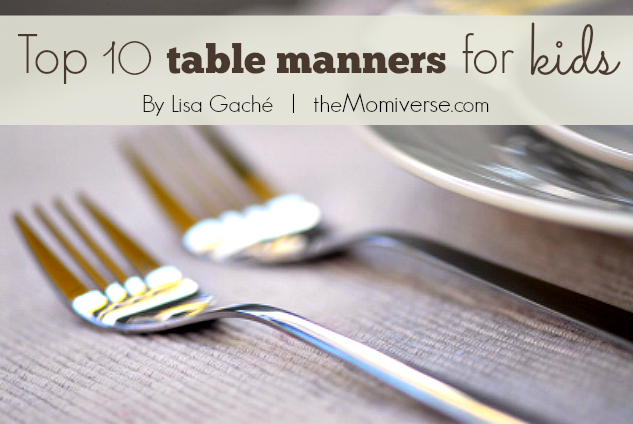It is never too early, nor too late to begin instilling the value and importance of learning proper table manners. From fast food etiquette to the family dining table, table manners are one of the most important skills parents can introduce to their children. The value of the table dining experience is tremendous. In addition to the warmth and comfort it provides for the family, it allows an opportunity for us to feed our bodies with a well-balanced meal, to share in the ritual of conversation, and to practice self-control. With the table dining experience everything slows down, including eating, which is so important to stress to today’s youth who are suffering from record numbers of childhood obesity. A little bit of dedication applied to this arena can go a long way to transforming the future of our family’s health and vitality. Here are the top ten best table manners to impress upon your children.
1. Use your napkin. The napkin is a wonderful invention. It has many practical functions and comes in all shapes and sizes. A napkin is used to wipe food from your mouth, to blot your lips before taking a drink, to catch crumbs or drippings that may fall into your lap or to use as a barrier if you happen to sneeze or cough while at the table. Before beginning your meal, lift your napkin with your left hand to open. Fold over the top quarter and lay the napkin in your lap with the fold pointing toward you. If you need to excuse yourself during the meal, place your napkin on the back or arm of your chair, when you return place it back in your lap. To signal the end of the meal, pinch the center of the napkin and place it on the left side of your place setting.
2. Help set the table and clear dishes. For many families coming together for dinner is a thing of the past except on special occasions. It is no wonder that our children do not know how to properly set a table. The bottom line is to use only the utensils and plates that are functional and that fit the number of courses you plan to serve. At the end of the meal, always offer to help clear the dishes. Remove all plates and glassware from the right. Never stack plates, carry only two plates at a time.
3. Chew with your mouth closed and keep elbows off the table! Nothing is more unpleasant than witnessing a fellow diner talk with a mouth full of food. Use your body language to communicate until you have had a chance to completely swallow the contents in your mouth. It is considered bad manners to keep your elbows on the table while eating, however your forearms are allowed on the table in between courses or when resting after you have completed your meal.
4. Use your utensils, not your fingers. Different cultures have different standards for table manners. In some countries it is perfectly acceptable to eat with your fingers, however in America we are taught to eat our food with utensils or silverware. Teach children to take pride in their table manners and learn the proper way to use these dining implements.
5. Practice the secret language of waiters. The resting position and the finished position are the secret codes to alert servers if a diner is taking a break or finished with their meal. To signal the resting position, use your fork and knife to make an inverted “V” on your plate this will ensure that your server will not remove your food should you get up from the table during your meal. To signal the finished position, close your fork and knife together at an angle on your plate. This lets your server know that you have completed your meal and that it is okay to take your plate.
6. Ask to leave the table. Ask permission before leaving the table whether you need to use the restroom during your meal or would like to be excused at the end of the meal. Place your napkin on the left hand side of your place setting, rise from the table and push in your chair. Offer to take your dishes to the kitchen.
7. Break bread. Tear off only a bite size piece of bread. Use your butter knife to spread a small amount of butter onto the piece that you wish to eat. Repeat same with each new piece of bread.
8. Make pleasant table conversation. With the loss of the family meal, children are missing a regular opportunity to practice their social skills including how to hold a conversation with others. Designate at least one night as family dinner night. Choose a theme to make it festive. Take turns sharing one good thing that happened during the day or try engaging in other topics such as the weather, cultural or sporting events or upcoming plans for the family.
9. Learn how to eat like the French. There are two styles of eating, the Continental style and the American style. Most Europeans practice the Continental style of eating their food with their fork in the left hand and the knife in the right. The fork tines are face down and used to gently stab the food while the knife acts as the pusher. The pattern is to cut and then eat, cut and eat. It is much more efficient way of dining and presents a more polished appearance.
10. Compliment the chef! It is always appreciated when someone takes the time to prepare a meal. Whether your parents ordered in or slaved over a hot stove, the preparation and display of the food on the table is worth the recognition so take a moment to acknowledge them and say thank you.
This Week's Articles Read, learn, live
-
 Summertime grilled vegetables
Summertime grilled vegetables
-
 5 Ways to make this summer full of unforgettable family fun
5 Ways to make this summer full of unforgettable family fun
-
 10 Reasons to take a family vacation in Puerto Vallarta
10 Reasons to take a family vacation in Puerto Vallarta
-
 5 Fun tips for spring cleaning with kids
5 Fun tips for spring cleaning with kids
-
 10 chick flicks with New Year’s Eve scenes
10 chick flicks with New Year’s Eve scenes
-
 The day after Christmas: 5 ways to handle the biggest downer of the year
The day after Christmas: 5 ways to handle the biggest downer of the year

{ 1 comment }
My maternal grandmother harped on manner and now my daughter refers to my mom as “Grandma Manners.” I am grateful to my grandmother for instilling good manner in me. I am proud of myself and one day, my daughter will be see the value in manners and be proud of herself.
–Mali
{ 1 trackback }